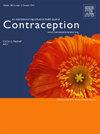多布斯诉杰克逊妇女健康组织在限制州促进堕胎护理的影响
IF 2.3
2区 医学
Q1 OBSTETRICS & GYNECOLOGY
引用次数: 0
摘要
在Dobbs之前,在威斯康星州的各个卫生系统中,堕胎护理的提供和患者对“转诊”的需求存在很大差异。在多布斯之后,威斯康辛州的医生们面临着一项1849年的州法律,该法律被广泛解释为除了挽救生命的紧急情况外,堕胎是犯罪行为。我们记录了后多布斯法律景观如何塑造妇产科医生(Ob-Gyns)如何促进怀孕患者的堕胎护理。方法:在Dobbs之后,我们在2023年9月至12月期间从农村和城市地区招募了21名不同医院附属机构、执业范围和个人人口统计学的妇产科医生参加虚拟访谈。采访探讨了在全州范围内禁止堕胎的威胁下提供怀孕护理的经历。调查人员编码和分析定性数据使用结合归纳演绎的方法。结果参与者描述了在多布斯手术后促进以患者为中心的流产护理的困难。转诊做法从卫生系统内部或系统之间的直接转诊到不太正式或不存在的转诊程序。促进护理的机构支持程度差别很大。与会者指出,由于缺乏健全的转诊系统,导致患者护理延迟和中断。机构支持的缺乏加剧了患者的障碍和负担过重的医生。在多布斯案之后,一项刑事堕胎禁令增加了威斯康星州人对堕胎护理的需求和障碍。医疗保健系统在加剧这些挑战方面发挥了重要作用。在限制堕胎的情况下,机构应积极建立和支持在州内和州外为需要堕胎的患者提供转诊途径。本文章由计算机程序翻译,如有差异,请以英文原文为准。
THE IMPACT OF DOBBS V JACKSON WOMEN’S HEALTH ORGANIZATION ON FACILITATING ABORTION CARE IN A RESTRICTED STATE
Objectives
Prior to Dobbs, the provision of abortion care and patient need for “referral” differed widely across health systems in Wisconsin. Following Dobbs, Wisconsin physicians faced an 1849 state law widely interpreted to criminalize abortion except in life-saving emergencies. We documented how the post-Dobbs legal landscape shaped how obstetrician-gynecologists (Ob-Gyns) facilitated abortion care for pregnant patients.
Methods
Following Dobbs, we recruited 21 Ob-Gyns from rural and urban areas with varying hospital affiliations, scopes of practice, and individual demographics to participate in virtual interviews between September and December 2023. Interviews explored experiences providing pregnancy care under the threat of a statewide abortion ban. Investigators coded and analyzed qualitative data using a combined inductive-deductive approach.
Results
Participants described difficulties in facilitating patient-centered abortion care following Dobbs. Referral practices ranged from direct referrals within or between health systems to less formal or absent processes. The degree of institutional support for care facilitation varied widely. Participants cited a lack of robust referral systems as contributing to delayed and discontinuous patient care. The absence of institutional support exacerbated barriers for patients and overburdened physicians.
Conclusions
Following Dobbs, a criminal abortion ban increased the need for and barriers to facilitating abortion care for Wisconsinites. Healthcare systems played a significant role in compounding those challenges. In abortion-restricted settings, institutions should actively build and support referral pathways for their patients in need of abortion, within and beyond state borders.
求助全文
通过发布文献求助,成功后即可免费获取论文全文。
去求助
来源期刊

Contraception
医学-妇产科学
CiteScore
4.70
自引率
17.20%
发文量
211
审稿时长
69 days
期刊介绍:
Contraception has an open access mirror journal Contraception: X, sharing the same aims and scope, editorial team, submission system and rigorous peer review.
The journal Contraception wishes to advance reproductive health through the rapid publication of the best and most interesting new scholarship regarding contraception and related fields such as abortion. The journal welcomes manuscripts from investigators working in the laboratory, clinical and social sciences, as well as public health and health professions education.
 求助内容:
求助内容: 应助结果提醒方式:
应助结果提醒方式:


